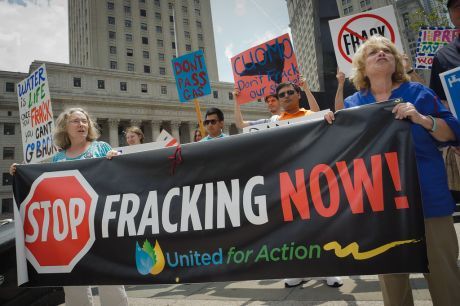Report on Business
You are here
What is fracking? What are the environmental consequences?

February 4, 2014
Fracking (hydraulic fracturing) is the process of extracting natural gas—also known as shale gas—by drilling into shale rock formations deep underground. Shale rock geology does not allow natural gas to flow in amounts large enough to be economical unless there are fractures (cracks) in the rock.
Early natural gas wells were sited over natural fractures in shale, but an estimated 60 per cent of new wells are sited where fracking has artificially created wells to allow natural gas flow. Wells are made by injecting a liquid mixture of water, sand and chemicals at high pressure into a wellbore (hole) so that small fractures are created in the shale rocks.
Natural gas is a hydrocarbon gas mixture that is primarily methane. It stays in a gaseous state at normal temperatures, which makes it difficult to transport from the source. This is why the gas is liquefied by cooling it, as it takes up less than 1 per cent of the volume.
Un-natural gas
Proponents of fracking point to studies that show burning natural gas releases less carbon dioxide than burning coal or oil, arguing that natural gas is “cleaner” than these fossil fuels. However, that applies only to the final consumption. When the fracking, liquefaction and shipping of liquefied natural gas (LNG) is included, it produces more green house gases than coal. It also has a slew of other negative environmental effects.
The liquid mixture injected to create fractures use any of 2500 chemical additives, 650 of which are known or possible human carcinogens either regulated under the US’s Safe Drinking Water Act or listed as hazardous air pollutants. Many fracking companies do not even disclose their entire components list, claiming “proprietary” or “trade secret” ingredients.
Fracking is extremely water intensive. The average well uses 4 to 13 million litres of fresh water in the injected mixture. As more fracking occurs, rapid depletion of rivers and underground aquifers will follow, leading to water shortages for domestic and agricultural use. The injected mixture could also contaminate both ground and surface water and land as a result of spills and flow-back (which will concentrate toxic matter such as salt, uranium and radon).
Fracking wells also lead to increased and stronger earthquakes. Ohio, Texas and Oklahoma as well as regions of the UK have recorded tremors of magnitude 3 on the Richter scale and higher. Prior to fracking many of these regions had never recorded earthquakes. From the West coast to the Maritimes, fracking operations further destroy indigenous land.
All of this is in pursuit of fossil fuels that we no longer need and whose consumption is adding to the climate crisis.
Section:










